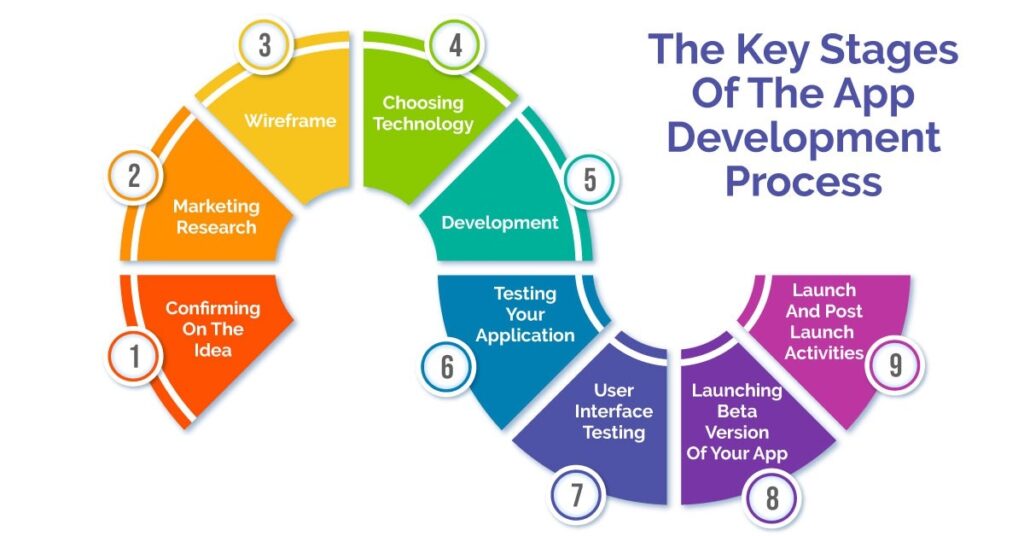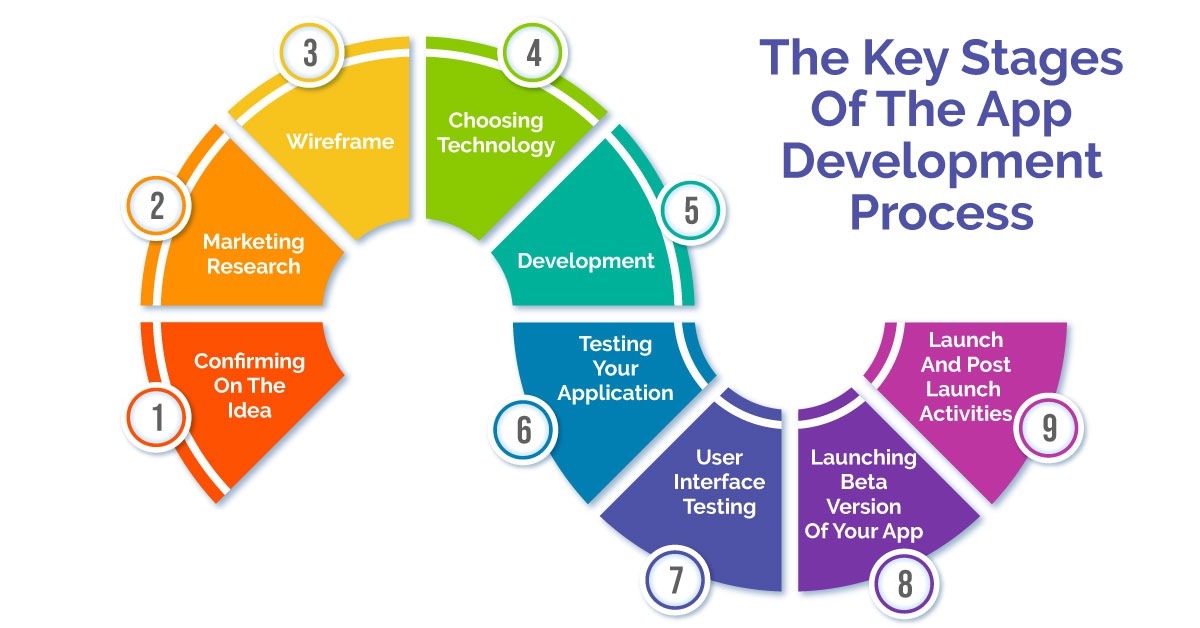
1: Confirming On the thought
Before getting to proceed, you would like to answer the subsequent inquiries to confirm that you simply aren’t marrying the incorrect idea, and therefore the idea is worth investing time and energy .
• App Objective: Why does one want to create a mobile app? Is it really needed in your businesses? Is your idea appropriate or an excellent fit, consistent with your company’s/target audience needs? does one have enough resources to market it?
• Target Audience: Who is your target audience? Who are the potential users?
• App USP: What are the important features? what’s the core appeal of your app? How’s your app different and why should your audience use it?
• Competitor Analysis: Who are your competitors? Do they need an identical application? If yes, is your idea of solving the matter during a better way than them?
• App Investment: Any app development would require money, effort, and time from you. Are you ready?
• App Marketing: When and the way will you promote your application? what’s your promotional strategy for the primary 500 users?
2: marketing research
Now is the time to try to to the foremost important a part of your journey. marketing research shows you the important demand or interest of the market; accordingly, you’ll modify your idea, and therefore the research can offer you a transparent list of requirements which will assist you prioritize the work. Here the question, of course, is the way to do marketing research the proper way? Check the step by step marketing research process here:
• Define your objective and customer persona
• Prepare your research survey questions
• Identify some of that persona to interact
• Speak to people in every a part of your target customer’s business
• Keep survey informative
• List your market competitors and do desk survey also
Here are some more advantages to doing market research:
• It helps you to take care of a far better understanding of your customers
• Get a transparent idea about your competitors
• Helps you assess your product carefully before launch
• Helps you define how you’ll reach the audience
3: Build Your App’s Wireframe
Once your idea list is prepared , it’s time to place a shape to your idea- Wireframes. you’ll consider a wireframe as a blueprint of your developing mobile application. it’ll display the planning of your app and functionality. Also, it’ll assist you understand the design and therefore the work of the appliance .
• Set a Mobile Frame – it’s better to pick a frame that has dimensions of the particular device that you simply design. Firstly, the frame should act as a natural constraint, it’ll avert you from adding too many elements in one screen. Secondly, a frame should be generating an illusion of actual frame design. we might wish to recommend starting with a middle screen size device.
• Use Design Patterns – Familiarity is that the most vital aspect of UX design. When users see familiar interface elements during a new product, they will believe their past experience when interacting with this new product.
• Ensure Your Content Scales Well – Will your screen design look good on an iPhone XS? But will it also look great altogether the screen sizes? If your screen design looks great on a medium-size phone screen like iPhone XS, it doesn’t mean that other phone users will have an equivalent experience. While it’s fine to start out with middle screen size when wireframing, it’s also important to see how your content looks on the various screen sizes and adjust it consistent with the dimensions . Different tools to see wireframes are InVision, UXPin, JustinMind, Figma, and lots of more.
4: Platform Choice
Now we are getting to assist you make the proper decision among all the platforms of developing mobile application phases. Three options are available within the sector of development:
• Native App: With the support of development language and tools developers can develop an application in specific platforms like Android, iOS.
• Cross-Platform App/ Hybrid App: Single developing mobile application built on HTML5 and may be run on multiple platforms. They’re downloaded from all the app stores like native applications.
• HTML5 Web App: it’s actually optimized mobile websites that appear to be sort of a native application and run on the mobile browser. This web application is platform-independent and lags to possess a superior user experience and functionality. Most useful to be built for cases where either the appliance isn’t allowed by respective app stores or end users aren’t expected to be motivated to download the app.
5: Development
If your mobile app design passes the test of usability, it’s time to offer a correct structure to your dream project. This process covers the If your mobile app design passes the test of usability, it’s time to offer a correct structure to your dream project. This process covers the coding part and therefore the actual realization of your application. The development of mobile application stages incorporate multiple activities like establishing the acceptable development environment, developing different parts of the code, preliminary testing, and creating the mobile application which will be installed and tested.
One development project would require programming and configuring the event environment. Usually, there are three aspects of any app- back-end, APIs, and therefore the app front-end. Development is typically wiped out stages and ready to “> you’ll expect your developer to supply interim builds that you simply are going to be able to run on your device itself.
Back-End/Server Technology
Database and server-side objects become imperative for supporting functions of your mobile app by connecting to a network. Configurations and changes might be needed to support the specified mobile app functionality if you’re using an existing backend platform. The server-side objects developed during this stage must be configured and tested with the opposite components of the app.
Application Programming Interface
An API may be a set of practices, protocols, and tools for developing software applications. It specifies how software components interact. Additionally, this programming interface is employed when programming GUI components.
Mobile App Front-End
The front-end called “client-side” programming is what your app users interact with. It implements the specified structure, design, animation, and behavior that you simply can see on the screen once you open up the websites, web applications, or mobile apps.
Now various tutorials are available which will assist you to develop your app without experts. otherwise you can fork over the planning to an development of mobile application company or a contract developer.
6: Test Your App And Improve
Running a code review process during developing mobile application helps in ensuring that there are not any major bugs left at the top to unravel . Here is our development process aligned with code review as a part of everyday code.
7: Launch A Beta Version Of Your App
A beta version of any application can attract early adopters, which is a crucial step in taking your mobile app mainstream. Early adopters provide tons of beneficial feedback about your application’s pros and cons. And their experience and rating can assist you to know the acceptance of the app and therefore the demand also . this sort of word-of-mouth marketing for your mobile app will bolster its reputation, and help the admin to accumulate even more users.
8: Launching Your App
You have designed the structure, tested, and developed your application. Now it’s time to launch it within the Google Play Store or Apple store.
How are you able to Submit Your App within the App Store And Google Play Store?
To provide you a thought about the Apple Store submission processes, we are getting to highlight some basic submission processes.
• Create an iOS profile & distribution certificate
• For your app create an iTunes Connect record
• Archive & upload your mobile app by Xcode
• Configure your mobile app’s metadata and other details within the iTunes Connect record
• Submit your application for review
• Check on the app status
Let’s get a thought about the submission process of the Google Play Store:
• Get your mobile app information ready
• Upload the APK or mobile app bundle files for your application
• Set your mobile app’s content rating
• Set app’s pricing and
• Set a distribution plan
• Publish your application
9: Post Launch Activity
After launching your mobile app, subsequent and crucial step is marketing it. If people don’t get to understand about your app, then there’s no chance of downloading it. To spread your app and convince people to explore it, consider making attractive and informative videos which will show your app’s functionality. And don’t forget the potential of social media, use all digital platforms to succeed in every corner of the planet . it’ll deliver people a glimpse of your app and highlight the key features which will simplify the necessity for all times .

